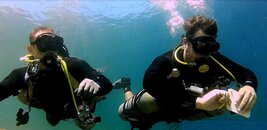As far as hose lengths and SPG goes, how long should the pony regulator be? 24",30"? Also, should you just check the psi before the dive or should you mount a SPG on a short hose? Does this add to another entanglement hazard and offer the risk of confusing hoses?
Length of hose will depend on how you plan to route/secure the regulator. I sling on the left and use a 28 inch hose secured with bungee to the tank then have the regulator hooked to first stage for easy deployment. I practice this setup until changing over is routine. There is no way for me to confuse hoses. I am considering a slightly longer hose in the future because I do feel some tension on the hose when using. As for the SPG, I use the button gauge and have it mounted so that I can view it while diving but keep in mind it is very small and may be difficult for some to see. This is the one I use.
Mini-SPG, {1 in | 2.5 cm} Face. Submersible Pressure Gauges (SPGs) - Dive Gear Express
If it is strictly back up only, some divers simply confirm pressure before the dive and do not use a SPG on the pony while diving. I considered ths option but personally did not feel comfortable with this so compromised with the button gauge.
Thanks, I assume that when using stage or deco bottles the 6" hose becomes less overkill. As far as entanglement and confusion goes, is the 6" hose riskier then the button gauge? Or is it just practice and muscle memory that gets this out of the way?
I do not dive where entanglement is typically an issue but I keep all my gear secured but removable and dive with a knife. I can not imagine a situation where the 6 inch hose should be an issue with a competent diver.
BTW, if you dive with BCD rather than BP/W, make sure you have the attachment points to sling a pony. If not, you should be able to add this to most BCDs.





